
Part III: The School
Social unrest prevents Gurdjieff from formalizing his work…
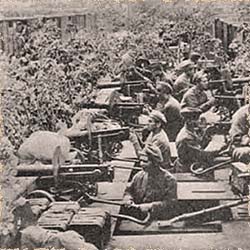
Russian Civil War (1917 – 1923)
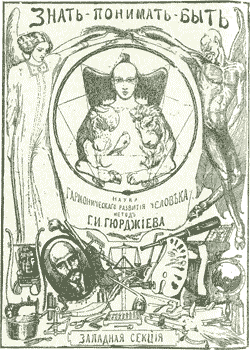
Prospectus for Gurdjieff’s Institute in Tiflis

Institute for the Harmonious Development of Man
Gurdjieff’s Informal Attempts at establishing a school
In 1919 he makes a first attempt to found a school in Tiflis, Georgia, under the title of Institute for the Harmonious Development of Man. To arouse local interest, a flier is circulated with the following information:
With the permission of the Minister for National Education, the Institute for the Harmonious Development of Man based on George Ivanovich Gurdjieff’s system is being opened in Tiflis. The Institute accepts children and adults of both sexes. Study will take place morning and evening. The subjects of study are: gymnastics of all kinds (rhythmical, medicinal, and others). Exercises for the development of will, memory, attention, hearing, thinking, emotion, instinct, and so on.i
[PETER OUSPENSKY] “To this was added that Gurdjieff’s system was already functioning in Bombay, Alexandria, Kabul, New York, Chicago, Copenhagen, Stockholm, Moscow, and Essentuki. At the end of the prospectus, in a list of ‘specialist teachers’ of the Institute, I found my own name.”i

Russian Civil War (1917 – 1923)
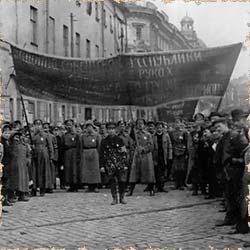
October Revolt (1917)
Students Begin Harboring Doubts
Most of Gurdjieff’s moves surprise his students. From the very outset, his maneuvers are meant either to shock his students, or are guided by considerations incomprehensible to them. In the case of the Institute for the Harmonious Development of Man, he hypes up his presentation in a commercial tone that, in the mind of many of his followers, is unwarranted. The ideas and methods should speak for themselves. Perceiving this, cracks begin to form between him and some, most significantly Ouspensky, who will continue distancing himself and eventually part from Gurdjieff to establish independent groups in London.
[PETER OUSPENSKY] “Gurdjieff was obviously obliged to give some sort of outward form to his work having regard to outward conditions, [but] I was not very enthusiastic about the program of the Institute for the Harmonious Development of Man… whose outward form was somewhat in the nature of a caricature.”i

Prospectus for Gurdjieff’s Institute in Tiflis
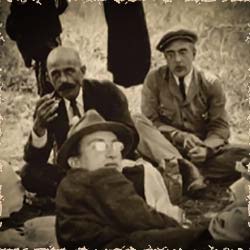
Gurdjieff and Ouspensky Circa 1915

October Revolt (1917)

Gurdjieff and Ouspensky Circa 1915

Location of Gurdjieff’s first Institute

Methods of Gurdjieff’s School
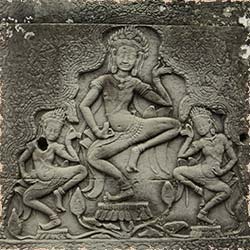
Temple Dancers, Bayon, Cambodia

Initiation of a Priestess (from a demonstration by Gurdjieff’s Pupils at the
Theatre des Champs-Elysees, December 1923)
Specialty of the Teacher
[GURDJIEFF] “There are no general schools; there are only special schools. Every teacher, or guru, is a specialist in some one thing. One is an astronomer, another a sculptor, a third a musician. And all the pupils of each teacher must first of all study the subject in which he has specialized.”i
One of Gurdjieff’s specialties was sacred dance. In his autobiographical account of his travels, in the book Meetings With Remarkable Men, he mentions a special interest in the dances of the different destinations during his two-decade period of search.
Many ancient temples, especially those from the East, incorporated sacred dance into their routine. The dances were usually performed by girls dedicated at a young age to the temple and trained specifically for these purposes. The movements brought to life the otherwise static and inanimate temple sculpture and painting. In Hindu temples, for example, almost all the major stories were conveyed through Indian dance and in many of the surviving temples we can still find sculptures and reliefs of dancers frozen in these postures.
When Gurdjieff first advertises his work in Russia in 1914, he advertises it in the form of a ballet called The Struggle of the Magicians. In the summer of 1916, during the Finland gathering, Gurdjieff shows his pupils postures and physical movements. But it is only in 1919, when the stage designer Alexander Salzmann and his wife the dance teacher Jeanne Salzmann join him, that he is able to properly execute these ambitions.
A school has to have an external form. You have to bring students together under the canopy of a certain external task. Only then does work transition from theory to practice. The teacher’s specialty serves as a vessel for this. Through it, students can interact, their characteristics brought out, and they can be pushed beyond their comfort zones to new levels.

Temple Dancers, Bayon, Cambodia

Whirling Dervishes, Constantinopol

Initiation of a Priestess (from a demonstration by Gurdjieff’s Pupils at the
Theatre des Champs-Elysees, December 1923)

Whirling Dervishes, Constantinopol




Gurdjieff on Chief Weakness
[GURDJIEFF] “The method of the institute is a subjective one, that is, it depends on the individual peculiarities of each person. There is only one general rule which can be applied to everyone: self-observation.”ii
[THOMAS DE HARTMANN] “Mr Gurdjieff told us that it was absolutely essential for each of us to see their chief fault, the one around which turn all our stupid, comical, secondary weaknesses.”iii
[GURDJIEFF] “Every man has a certain feature in his character around which all his ‘false personality’ revolves. A man cannot find this chief fault by himself. This is practically a law. The teacher has to point out this feature to him and show him how to fight against it… Every man’s personal work then consists of struggling against this chief fault.”i
[PETER OUSPENSKY] “Gurdjieff was very ingenious in the definition of features… Whenever anyone disagreed with the definition of his chief feature given by Gurdjieff, he always said that the fact that the person disagreed with him showed that he was right.”i
[GURDJIEFF] “The struggle against one’s chief fault is the most important part of the work, and it must proceed in deeds, not in words. For this purpose the teacher gives each man definite tasks which require, in order to carry them out, the conquest of his chief feature. When a man carries out these tasks he struggles with himself, works on himself. If he avoids the tasks, tries not to carry them out, it means that either he does not want to or that he cannot work.”i
In 1921 Gurdjieff wraps up his institute and moves to Germany. In 1922 he visits England. Here, Ouspensky has already generated interest in the work, and despite his personal reservations with Gurdjieff’s methods, there seems to be a potential for collaboration. But the British government denies Gurdjieff residence. In the same year, he moves to France and buys a Chateau in Avon near Fontainebleau. Here, Gurdjieff will get his best chance at formalizing his activities in Europe.


Gurdjieff Establishes the Chateau Prieuré
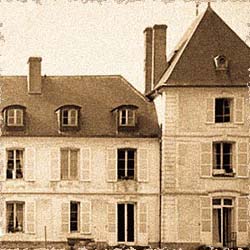
Chateau Prieure
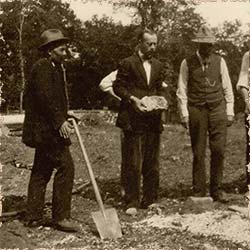

If Gurdjieff indeed intended to establish a school in the west, then so far wars and revolutions were objective limitations. The purchase of the Chateau towards the end of 1922 now removes any excuse.
[THOMAS DE HARTMANN] “The house was a remodeled mansion of the seventeenth or eighteenth century that once had been a monastery for priors, so it was called the Prieuré.”iii
The chateau is in disrepair. Restoration now becomes the focus of Gurdjieff and his followers.
[CHARLES NOTT] “Our daily life followed a routine that frequently changed. The getting-up bell rang from the tower at half-past six. Breakfast consisted of large hunks of toasted bread, with coffee; then came work in the gardens, or the forest, or the house.”iv
[THOMAS DE HARTMANN] “Mr Gurdjieff knew how to distribute work among people in such a way that not a moment was lost.”iii
[GLADYS ALEXANDER] “Life was spurred to a highly accelerated pace. It ranged from the heavy toil of an old-fashioned kitchen and scullery, from the work of the house and the laundry, the flower and kitchen gardens, to the care of horses, donkey cart, sheep, goats, cows and calves, hens, pigs, and dogs.”v
[CHARLES NOTT] “There was a break from half-past twelve to two for lunch. Tea was at four and supper at half-past six; movements and dances followed until ten or eleven. During the day Mr Gurdjieff gave general talks, and personal talks to individual pupils.”vi
[JOHN BENNETT] “Gurdjieff’s lectures which were always given at unexpected moments were for most of us the high spots of life at the Prieuré…”v

Chateau Prieure
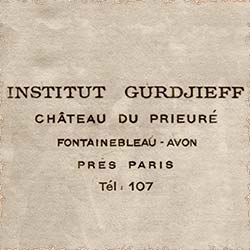
On Immortality
On one occasion someone asked whether life after death existed.
[GURDJIEFF] “In order to be able to speak of any kind of future life there must be a certain crystallization, a certain fusion of man’s inner qualities, a certain independence of external influences. If there is anything in a man able to resist external influences, then this very thing itself may also be able to resist the death of the physical body.”i
The Struggle Between ‘Yes’ and ‘No’
[GURDJIEFF] “All… ways to immortality can be divided into three categories:
- The way of the fakir.
- The way of the monk.
- The way of the yogi.i
The way of the fakir is the way of struggle with the physical body… The way of the monk… is the way of religious feeling, religious sacrifice… The way of the yogi… is the way of knowledge, the way of the mind.”
Just as you develop a muscle by flexing it beyond its natural ability, so do you develop unity by struggling against the multiplicity of the lower centers. The first way does this through struggle with the physical body, resisting its urges, going beyond its imaginary red lines, much like a professional athlete. The second way does this through subjecting all one’s emotions to a higher emotion such as faith. You see this in the Christian monastic life. The third does this through disciplining the mind, forcing it to ‘think’ rather than fantasize, to concentrate, meditate. You see this in Judaism.









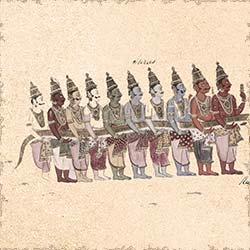
Devas (Gods)
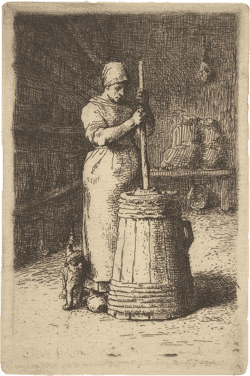
Woman Churning Butter, by Jean-François Millet
Inner Unity
[GURDJIEFF] “Inner unity is obtained by means of ‘friction,’ by the struggle between ‘yes’ and ‘no’ in man. If a man lives without inner struggle, if everything happens in him without opposition, if he goes wherever he is drawn or wherever the wind blows, he will remain such as he is.”i
Perhaps the most famous example of the struggle between ‘yes’ and ‘no’ comes from the Mahabharata. This scene is given central focus in the Khmer interpretation of Hinduism and it is tempting to consider that members of Gurdjieff’s Seekers of Truth might have visited some of its remaining temples, such as Angkor Wat.
The Hindu world-order relied on an equilibrium between good and evil. This equilibrium was periodically disturbed, endangering the existence of the entire cosmos. At one such mythical occasion, when the nectar of immortality was lost, Vishnu the preserver-god advised the devas and asuras to churn the milky ocean. They were to use the giant serpent Vasuki as a churning rope and Mount Mandara as a churning pole.
Churning was common in old world households. You churned wood to ignite a fire and churned milk to make butter. The idea of transforming something through churning is, therefore, rooted in nature. By the very same method, the human being could achieve inner unity and permanence: by methodically pulling against their chief weakness to affect an internal churn.
[THOMAS DE HARTMANN] “Every activity in the Work showed clearly that the aim was never for outer results, but for the inner struggle. For example, Mr Gurdjieff once sent everyone to prepare the earth for the kitchen garden, but later the garden was abandoned.”iii
[GUDJIEFF] “If a struggle begins in man, and particularly if there is a definite line in this struggle, then, gradually, permanent traits begin to form themselves, he begins to ‘crystallize.'”i
[THOMAS DE HARTMANN] “In such moments of superhuman effort one has to restrain the inner revolt that results from physical fatigue. What helped me was to look at myself as if from the outside, and laugh.”iii
[GLADYS ALEXANDER] “[Life in the Chateau] was lived in a seething atmosphere of speed and tension, of zeal and high hopes, punctured by bouts of inertia and criticisms, of lively friction and wordy contests. It was, indeed, a melting pot designed to reduce to their intrinsic value the ingredients that boiled and simmered within.”v
On the receiving end, the Westerners are having a good time. On the giving end, however — on Gurdjieff’s part — he has placed himself under immense pressure and responsibility. True to his own teaching, he embodies inner struggle, going against comfort and ease, not sparing himself the slightest effort.
It’s all on Gurdjieff’s shoulders. He must entertain. He must employ. He must lecture. He must find means of financing. He must bridge intervals and keep the octaves ascending. Let’s build a kitchen garden. Now a Turkish bath. Now let’s clear a stretch of forest, and so on. In effect, he is like a caretaker in charge of an orphanage with scores of children, shifting their attention from one activity to another, not letting them fall into destructive boredom. This reaches a climax with the visit to America.

Devas (Gods)

Woman Churning Butter, by Jean-François Millet

Asuras (Demons)
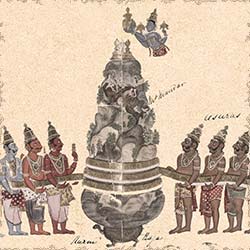
Mount Mandara as a Symbolic Churning Rod

Asuras (Demons)

Mount Mandara as a Symbolic Churning Rod


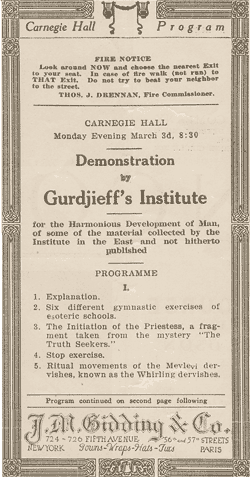
Brochure of Gurdjieff’s Demonstrations in Carnegie Hall
Gurdjieff’s School Visits America
In the spring of 1924, Gurdjieff sails from Paris to America with 35 pupil-dancers, where public demonstrations in New York, Philadelphia, Boston, and Chicago will be held.
[THOMAS DE HARTMANN] “We were all very happy to be going to America. Everyone, myself included, dreamed of triumphal demonstrations and the large profits so indispensable to Mr Gurdjieff for carrying out his future plans.”iii
Gurdjieff’s demonstrations in America are the most widely publicized moment in his career. Reporters had been invited to the Institute in France during the summer of 1923 to witness its activities, report of them in America, and generate interest prior to the tour.

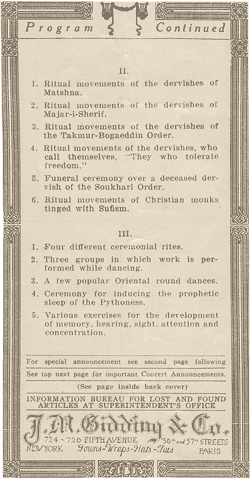
Brochure of Gurdjieff’s Demonstrations in Carnegie Hall
[CHARLES NOTT] “For a day and a half the New York papers gave a good deal of space to the demonstration. One of the baser sort of Sunday papers devoted two pages to it with pictures and fantastic captions… The succeeding demonstrations were packed to capacity.”iv
This venture is problematic. The sacred dances of the legendary Sarmoung Brotherhood, kept secret for thousands of years, are now on display in Carnegie Hall. Can we expect the audience to be in any position to value what they see?
[THOMAS DE HARTMANN] “As time passed, there were fewer and fewer people in our audience and we had no further prospects… The reality [of our visit to America became] mixed with difficulties… As always with Mr Gurdjieff, the goal was not a triumphal tour, but work and effort on ourselves every day in other circumstances – the simplest and humblest of living conditions and food in an environment of the most luxuriously tempting possibilities.”iii
The challenge with Gurdjieff’s trajectory is that it has to keep ascending. Each new project must outshine the previous one, justifying its abandonment. What act, then, can follow the triumphal demonstrations in America?



Gurdjieff’s Car Accident
In summer of 1924, after returning to France, Gurdjieff drives alone from Paris to Fontainebleau and has a near fatal car accident.
This will be a pivotal moment for Gurdjieff, his followers, and the Institute. There will be much internal debate about whether this could have been self-inflicted, or in other words suicidal. Given his many responsibilities and the extreme demands he had been placing on himself for the past several years, falling asleep on the wheel is certainly a simpler possibility. Either way, considering the perpetual reinvention of new projects at the expense of old abandoned ones, the endless financial challenges, we in hindsight aren’t surprised to see it ending in a crash — although we wouldn’t have expected it to be that literal.
[THOMAS DE HARTMANN] “During those first few nights Mr Gurdjieff lay motionless, completely quiet and without any signs of consciousness.”iii
[OLGA DE HARTMANN] “It was not even possible for him to drink; we only wet his lips with a damp cloth… After the third or fourth day, the doctors said that there was no danger to his life… Finally, on the sixth day he opened his eyes. He called his wife and asked her, “Where am I?””iii
[CHARLES NOTT] “That such an accident could happen to Gurdjieff was a shock to us; some thought that he should be invulnerable, free from the law of accident.”iv
Nursed by his wife and mother, Gurdjieff makes a slow and painful recovery, against medical expectation.
[CHARLES NOTT] “There was silence in the Prieuré; we spoke with lowered voices; the bell in the belfry no longer rang; there were no dances or music in the Study House, and everyone wished with his whole being for Gurdjieff’s recovery… it was as if the mainspring of a great machine had broken and the machine was running on its momentum. The force that moved our lives was gone.”iv
[THOMAS DE HARTMANN] “Mr Gurdjieff’s strange behavior lasted a long time… Throughout his illness we were on our own and had to depend on ourselves for every decision… It gradually became obvious that, though his body had been gravely affected, inside ‘Georgivanch’ remained ‘Georgivanch’. His acting had been in part to test how far we were capable of carrying on his Work without him.”iii
One morning word goes around that Gurdjieff wants everyone to assemble in the Study House…
[CHARLES NOTT] “We grouped ourselves around him… In a quiet voice he began to speak, sometimes in English sometimes in Russian. He said that he was going to liquidate the Prieuré.”iv
[GURDJIEFF] “In two days, everyone must be gone from here, only my own people stay. For a long time I live for others, now I begin to live for myself. Everything now stop — dances, music, work. You all must go.”iv
Sources
- In Search of the Miraculous by Peter Deminaovich Ouspensky
- Views from the Real World by George Ivanovich Gurdjieff
- Our Life with Mr. Gurdjieff by Thomas and Olga de Hartmann
- Teaching of Gurdjieff: A Pupil’s Journal by Charles Stanley Nott
- Gurdjieff: Making a New World by John Godolphin Bennett

Part I:
Gurdjieff
Part II:
The Teaching
Part IV:
Initiation
Part V:
Fourth Way